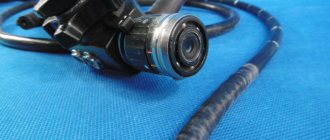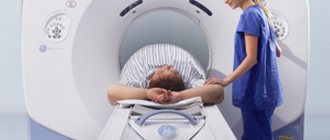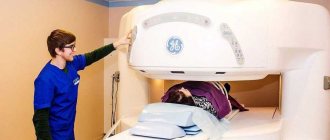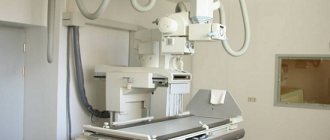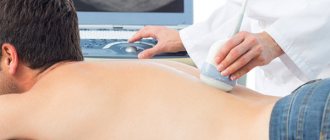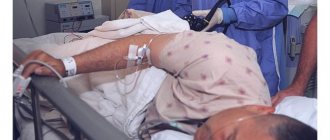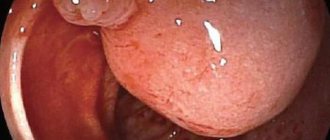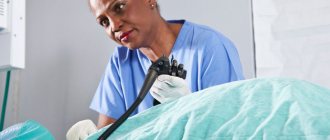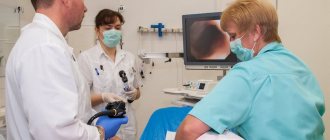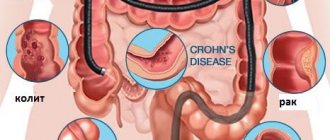Endoscopy is a modern and very popular research method. It is rightly called the gold standard for diagnosing cancer and other diseases of the digestive system. After all, endoscopic examination makes it possible to detect and specifically examine the slightest neoplasms and defects of the mucous membrane. Moreover, it does not involve any radiation, does not disrupt the functioning of organs, and can be performed the required number of times.
At the Digestive System Cancer Prevention Center, ICLINIC offers a comprehensive endoscopic diagnostic service: performing FGDS and FCS simultaneously and under anesthesia.
What can be revealed using FCS and FGDS
FGDS (fibrogastroduodenoscopy) is an endoscopic examination of the stomach, esophagus, and duodenum. During the procedure, the doctor, using an endoscope camera (fibrogastroscope), carefully examines the mucous membrane of these organs, paying special attention to places of tissue transition, natural folds and some areas of the typical location of erosions, ulcers, and neoplasms. The functioning of the sphincters and the contractile activity of the walls are also assessed, and if necessary, a biopsy of suspicious areas and fluid samples are taken.
Endoscopic examination of the stomach can reveal a number of pathological conditions:
- Inflammatory changes in the mucous membrane of a catarrhal or erosive nature.
- Esophageal and gastroduodenal reflux.
- Areas of atrophy.
- Ulcers.
- Scar adhesions.
- Diverticula.
- Protruding or infiltrating neoplasms of a benign nature (for example, polyps) or a malignant nature.
- External signs of local malignancy (malignization) of previously benign formations.
With FCS (fibrocolonoscopy), the condition of the mucous membrane of almost all parts of the large intestine (rectum, colon, sigmoid colon) is examined. In this case, polyps, diverticula, erosions and ulcers, bleeding areas located in the thickness of the tissue (infiltrating) or protruding tumors can be identified.
FCS and FGDS are the most important diagnostic methods that allow you to directly visualize any pathological changes in the mucous membrane and take tissue samples for histological examination.
Therefore, they are widely used by gastroenterologists, oncologists, and coloproctologists. A therapist or general practitioner can also refer a patient for such a study.
How to decide on FGDS or FCS and not go crazy with fear
You need to undergo an FGDS or FCS, but you just can’t bring yourself to sign up for the procedure, having heard a lot of reviews from friends who “swallowed the hose” and read “horror stories” on the Internet... What will the experts say? Will it hurt during the examination? How long does it last? How is it going? Who should it be shown to? Is there an alternative? These and other questions of concern to many were answered in detail and frankly by Kirill PYATKIN, an endoscopist at the Kivach clinic.
— Let’s first understand the abbreviation: what is FGDS?
— This is fibrogastroduodenoscopy, or gastroscopy, a visual examination using an endoscope of the mucous membrane of the esophagus, stomach, and the initial part of the duodenum. During the examination, the endoscopist can see various pathological changes - acute and chronic inflammation of the mucous membrane, areas of erosion, ulcers, various gastritis, as well as pathological formations, for example, polyps - local growths of the mucous membrane.
— Is it necessary to “swallow the light bulb”, because now many diseases of internal organs can be detected using, for example, tests, tomography, ultrasound? What are the advantages of endoscopic examination?
- All methods, be it tomography, for example, or fluoroscopy (when the patient drinks a contrast agent, usually barium, and then X-rays are taken) - these methods are in any case mediated by an image or tomogram (layer-by-layer image). If we talk about tumor markers, then this, again, is mediated by analysis.
And the endoscopic examination method gives the doctor the opportunity to look inside the patient. The essence of endoscopy is contained in the name itself: “endo” means “inside”, and “scopy” means “look”. That is, during a gastroscopy, the doctor evaluates everything visually. Also, during this study, the doctor has the opportunity to take material for a biopsy, if necessary. No other methods have such diagnostic value as visual inspection through an endoscope. Currently, gastroscopy is the most informative method for assessing the condition of the mucous membrane of the esophagus, stomach and the initial part of the duodenum.
— What symptoms serve as a basis for gastroscopy?
- The most common symptom is heartburn, followed by pain - both when hungry and after eating, a feeling of bloating, a feeling of indigestion of food. That is, any discomfort in the upper abdomen, one way or another associated with food, is an indication for gastroscopy.
— You also conduct FCS at the Kivach clinic. What kind of research is this and who is it for?
— FCS (fibrocolonoscopy) is an endoscopic method for diagnosing the large intestine. There are many indications for colonoscopy. This is a feeling of indigestion or bloating, anemia (decreased hemoglobin), constipation for 3-4 days, as well as heredity (if someone close to you had intestinal tumors, then you need to be checked regularly), cancer screening after 40 years.
— What can be detected during a colonoscopy?
— Congenital elongation of the intestine, a common pathology is elongation of the sigmoid colon, which is manifested mainly by constipation. You can also identify the presence of hemorrhoids and various types of colitis. The main purpose of a colonoscopy is to rule out cancer.
— One of the most important questions that worries everyone who is prescribed FGDS or FCS is whether it hurts?
— Gastroscopy is more unpleasant than painful. And the main reason is the gag reflex, which develops as the endoscope moves through the esophagus.
As for colonoscopy, the main painful moments can occur, firstly, when the endoscope passes the so-called corners of the intestine - there are two of them: splenic and hepatic. The intestine is fixed to the walls of the abdomen, and no matter how flexible the endoscope is, it slightly stretches the intestine from the inside, which can also be painful. Secondly, during the procedure we inflate the intestines from the inside: we supply carbon dioxide through an endoscope to straighten the intestines and look at all the walls. This is also a certain discomfort for the patient. However, it should be noted that everything is still very individual and depends on the patient’s pain threshold. Some people lie quietly, as they have no painful sensations, while for others, even the slightest advance of the endoscope already causes pain.
— How can modern medicine cope with this pain?
— At the Kivach clinic we use drug-induced sleep - intravenous sedation. A thin plastic catheter is placed in a vein, which can remain there for a long time, and a drug is administered through it (we use propofol). While propofol is dosed through a special device, the patient sleeps. As soon as we have completed the study, the administration of the drug stops, after 5-10 minutes the patient wakes up, and after 20-30 minutes he is already able to get to his feet, change clothes, meet with the doctor and discuss the results of the study.
— What are the advantages of the procedure under sedation?
— Well, firstly, all discomfort, including pain, is relieved. Secondly, if it is necessary to apply some kind of intervention, be it a biopsy or removal of formations, then it is more convenient to do this while the patient is sleeping. Vomiting during gastroscopy is excluded. Sedation is not the same anesthesia that is used during abdominal operations: here the patient breathes on his own, this is a deep physiological sleep. During the procedure, if necessary, you can even wake up the patient, for example, if you need to ask him to carefully turn on his side. That is, it is a controlled dream.
However, sedation is contraindicated for those who are allergic to egg white (since propofol is based on it), peanuts and soy.
Naturally, before sedation, cardiac activity, respiratory activity are examined, and tests are taken. This is all assessed together. If there are no contraindications due to concomitant pathology, then there is only one limitation - the above-mentioned allergy.
— How often are gastroscopy and colonoscopy prescribed in pairs: FGDS + FCS?
- Almost always. And at our Kivach clinic, as a rule, they are performed under sedation. With these two studies, the doctor can look at almost two-thirds of the gastrointestinal tract: the esophagus, stomach, initial part of the duodenum and large intestine. Only the small intestine remains, but according to statistics, the percentage of some formations, tumors, diseases, etc. The small intestine produces many times less than the stomach and large intestine.
— How long does this general study last?
— If there are no technical difficulties, you don’t need to remove anything, or make any interventions, then the study lasts 30-40 minutes. This is the average data.
— Tell us in more detail, how is everything going?
— Anyone who wants to make an appointment at the Kivach clinic for an examination is sent a questionnaire, which he fills out and sends to the clinic. Doctors, an endoscopist and an anesthesiologist, after studying the questionnaire, assess possible risks and contraindications.
On the day of the examination, the patient comes to the clinic, an endoscopist talks with him, then an anesthesiologist. It is discussed what worries the patient, whether there have been previous examinations, the doctor informs about what and how will happen during the examination, as well as about possible complications. The patient signs consent to the procedure (the document reflects everything that was discussed), then he goes to the office, changes into special underwear and lies down on the table. The nurse anesthetist places a catheter for sedation for the patient, connects a bunch of sensors to monitor cardiac activity, breathing, and attaches a pulse oximeter to his finger. Then the drug is administered and the patient falls asleep. The doctor first does a gastroscopy, looking at the upper parts of the gastrointestinal tract. If necessary, he takes tests and a biopsy. When the gastroscopy is completed, the nurse takes the gastroscope to the washing machine in a special machine. Then a colonoscope is connected and a colonoscopy is performed. In the same way, if something needs to be taken or removed, the doctor does it. When we finished, we took the colonoscope for processing. All. Next comes the patient’s awakening. When the patient has regained consciousness, the results of the study are discussed with the doctor.
— Do I need to prepare in advance somehow?
— Before gastroscopy, you need a 6-8 hour fasting period. As a rule, we try to schedule this test in the morning, that is, it is enough not to have breakfast or drink water in the morning.
Colonoscopy requires preparation - special medications that have a laxative effect and cleanse the intestines. This is mainly fortrans or picoprep. We always give you a diagram of how to take them. We also give you the recommended diet.
That is, gastroscopy means hunger. Colonoscopy requires certain medications plus a special diet. Before sedation, fluids and food are strictly limited to prevent aspiration—the penetration of gastric contents into the airways.
— Are there any contraindications to these endoscopic studies?
— Contraindications are life-threatening conditions: heart attacks, strokes. As a rule, everything is clarified at the examination stage before the procedure. A limitation to the procedure is the use of anticoagulants (blood thinning drugs); in this case, research can be carried out, but any manipulation of the mucous membrane cannot be done.
— Does the patient feel discomfort after the procedure?
— Yes, there is sometimes discomfort, especially after a colonoscopy. This may be a feeling of bloating, a feeling of cramping in the abdomen. But at the Kivach clinic we use carbon dioxide rather than air to inflate the intestines. Firstly, it is absorbed from the intestines into the bloodstream 16 times faster than air, and secondly, it has a certain relaxing effect on the intestinal muscles.
— Based on your practice, can you say what patients are most afraid of?
— Diagnosis: tumors. And anesthesia.
— What do you usually tell your patients before starting a study? How do you configure them?
— Our dialogue usually develops constructively, based on trust. We will calm those who are afraid. For those who have never done this procedure, we will tell you how everything goes, we will show you the tools and equipment. If necessary, I will show a video recording, naturally, impersonal, of what exactly we see inside, what we can do. It is necessary to interest the patient, then the fear goes away immediately.
Advantages of comprehensive endoscopic examination
- Expansion of diagnostic capabilities. When performed simultaneously, the FGDS procedure and colonoscopy make it possible to assess the condition of almost all parts of the gastrointestinal tract. The doctor examines 3 areas at once that are characterized by a high probability of cancerous tumors: the stomach, duodenum, and large intestine. Such an integrated approach gives confidence in a reliable diagnostic result.
- Save time. The patient does not have to prepare for the procedure twice and visit the clinic again; he undergoes a full diagnosis in one visit to the doctor.
- There is no unpleasant sensations or psychological discomfort from the procedure, because fibrogastroduodenoscopy and colonoscopy with anesthesia are performed. The patient is under anesthesia or in a state of medicated sleep throughout the examination.
- Reducing the cost of diagnostics. General anesthesia during video colonoscopy and FDGS increase the cost of each procedure, and their simultaneous implementation allows the use of anesthesia only once.
Indications for both procedures in 1 session
It is possible to combine gastro- and colonoscopy in the presence of symptoms that indicate damage to the upper and lower parts of the digestive tract, as well as in the absence of pronounced symptoms against the background of rapid weight loss, general deterioration in health and untreatable iron deficiency anemia. Such signs may indicate tumor processes, for the accurate diagnosis of which colonoscopy and FGDS are intended.
Also, indications for performing two diagnostic procedures on one day include:
- gastric and/or intestinal bleeding with the inability to establish the exact location of the source;
- obstruction of the digestive tract and intestines (except the esophagus);
- foreign objects in the gastrointestinal tract.
Also, simultaneous colonoscopic examination and gastroscopy are indicated to clarify the diagnosis and localization of neoplasms in diffuse polyposis of the digestive tract, previously diagnosed oncology and suspected metastases in the intestines or stomach.
Is anesthesia really necessary for complex endoscopy?
Most people experience significant psychological discomfort just looking at a video endoscope. They develop anxiety, fear of pain, motor restlessness, blood pressure may increase, heart rhythm disturbances and spasmodic contractions of the esophagus and intestines may develop. All this is not only uncomfortable for the patient, but also complicates the work of the endoscopist, especially when performing colonoscopy.
General anesthesia can cope with this problem. Examination of the intestines under anesthesia is painless. The patient does not experience fear or physical discomfort, and relaxation of his muscles during medicated sleep facilitates the insertion of the endoscope. Therefore, FGDS and colonoscopy under anesthesia are increasingly being practiced.
Of course, if there are contraindications to general anesthesia, this examination can also be performed under local anesthesia. This does not affect the effectiveness of endoscopy, but it does cause some discomfort to the patient.
What is colonoscopy and gastroscopy
An examination of the intestines is carried out using a colonoscope, which is a device with a long probe equipped with an optical video camera. It allows you to examine the intestines from the inside, make a video recording of the examination and display the image on the monitor.
Using a colonoscope, you can perform surgical and diagnostic procedures, such as removing polyps, taking material for a biopsy, and delivering medications directly to the site of pathology.
Gastroscopy is an examination of the stomach using a gastroscope equipped with a long probe that is inserted through the esophagus into the stomach. The device is equipped with an optical system that allows you to examine not only the gastric mucosa, but also diagnose the duodenum. In this case, the following methods are used:
- EGDS – esophagogastroduodenoscopy;
- FGDS – fibrogastroduodenoscopy;
- FGS – fibrogastroscopy.
The principle of these techniques is the same for everyone. The only difference is in the depth of the examination. As a rule, gastroscopy is performed as an additional examination of the stomach after an ultrasound scan, which showed any abnormalities.
These examination methods are especially valuable for excluding malignant tumors, which can be detected at the earliest stages of development, confirmed by histological examination.
Preparing for the examination
To perform an FGDS of the stomach under anesthesia, you should abstain from eating for at least the previous 12 hours. This is necessary to ensure a sufficient degree of visualization of the study and to prevent involuntary reflux of food gruel from the stomach into the esophagus and then into the respiratory system. Preparation for fibrogastroduodenoscopy also includes abstaining from alcohol, chocolate, irritating foods and spices. It is advisable to limit smoking.
In a combined study, such measures are not enough. Preparation for colonoscopy with anesthesia also includes mandatory cleansing of the large intestine, and not only its final part. To do this, a restrictive diet is prescribed for 5–7 days (to reduce fermentation processes and intestinal gas formation), and the last meal should be no later than 24 hours before the procedure. Additionally, on the recommendation of a doctor, laxatives are used, they are taken according to special regimens. It is necessary to achieve liquid, almost transparent and slightly colored stool.
The use of anesthesia also requires patient preparation. It is necessary to make sure that he has no contraindications to anesthesia; for this, a preliminary examination is prescribed. It includes:
- General blood analysis.
- Biochemical blood test.
- ECG.
- If the patient has chronic cardiovascular, neurological and systemic diseases, consult a therapist to obtain a conclusion about the absence of a contraindication for anesthesia.
Careful, competent preparation for examination at the ICLIBIC clinic reduces the risk of complications and allows you to achieve high quality visualization during colonoscopy.
Colonoscopy and FGDS simultaneously under anesthesia
Colonoscopic examination is often performed under general anesthesia due to the specific nature of the manipulation, pain, and involuntary contractions of the smooth muscles of the intestine, which prevents the passage of the probe and contributes to the development of complications. Given the absolute anesthesia during colonoscopy, it is possible to combine manipulation with fibrogastroscopy.
The advantages of simultaneous implementation are:
- Reducing the load on the body from anesthesia;
- Accurate determination of the source of bleeding, polyps, tumors;
- Assessment of the condition of the entire length of the digestive tract.
Anesthesia eliminates pain and involuntary contraction of smooth muscles. In the absence of contraindications, clinicians decide to conduct a combined examination for special indications against the background of an unclear clinical picture.
When and to whom is complex endoscopy of the gastrointestinal tract indicated?
Fibercolonoscopy and examination of the stomach are performed according to indications. Basic recommendations for such diagnostics:
- previously diagnosed chronic diseases of the digestive system;
- the appearance of bloody and mucous impurities in the stool;
- recurrent abdominal pain;
- unstable stool, with alternating constipation and a tendency to diarrhea;
- the presence of indirect signs of cancer pathology (weight loss, changes in blood composition, persistent low-grade fever);
- palpable lump in the abdomen or identifying signs of a tumor using ultrasound or other diagnostic techniques.
FCS and FGDS are carried out not only for one-time diagnostics. Endoscopy is widely used for routine preventive examinations of patients with an increased risk of cancer, including those with a hereditary history of cancer of the digestive system.
Endoscopic examinations of the gastrointestinal tract make it possible to identify precancerous conditions and tumors of even small diameter, perform a biopsy and remove small tumors. Therefore, regularly performed FGDS and FCS are effective prevention of cancer of the digestive organs.
After the examination
As a rule, there are no serious complications from the use of anesthesia. The patient may experience weakness, dizziness, discomfort in the anus and throat, and inability to concentrate. After a short time, the uncomfortable symptoms go away on their own and do not require special therapy. If the condition is aggravated by pain in various parts of the gastrointestinal tract, fever, loss of consciousness, heavy rectal bleeding, difficulty breathing, this requires immediate contact with a medical specialist.
If there are any changes in your health after the procedure, you should immediately tell your doctor
The person undergoing the examination is given the following recommendations:
- Do not eat for 2–3 hours after diagnosis. At the same time, the first meal should be small in volume and consist of light foods (soft low-fat cottage cheese, yogurt, boiled oatmeal).
- For 2–5 days, adhere to the diet used during the preparatory period.
- Avoid drinking alcohol and carbonated drinks for at least a week.
- Limit coffee and chocolate.
- Avoid exposing your body to physical activity for two to three days, including postponing sports training;
- Refrain from driving until the anesthetic substance is completely removed from the body.
Examination at ICLINIC: high quality and reliability of diagnosis
ICLINIC is a specialized Digestive System Cancer Prevention Center. Highly qualified doctors, the use of high-quality endoscopic equipment, and a competent approach ensure expert diagnostic quality and the reliability of the results obtained.
Advantages of examination in our Center:
- Low risk of tissue trauma. During diagnosis, colonoscopes of reduced diameter and gastroscopes with thin, ultra-flexible tubes are used, which, in combination with modern anesthesia, allows one to avoid pain during the procedure and after removal of the device.
- High information content and reliability of the survey. The cameras of the endoscopes used in ICLINIC allow for microscopic examination of the surface of the mucous membrane, obtaining HD+ quality images and using a high-precision virtual chromoendoscopy mode. A large number of working channels and additional software increase the speed and effectiveness of tests.
- Safety. Anesthesia and anesthesia are provided by an experienced anesthesiologist using modern certified drugs. The patient's condition is controlled by a modern life support system.
- Possibility of taking a biopsy and simultaneous removal of detected tumors.
An examination at ICLINIC means highly reliable diagnostics, comfort and safety for the patient.
Gastroscopy using the PENTAX MEDICAL endoscope
Why is gastroscopy necessary?
The procedure is performed in order to:
- Detect gastritis, ulcers, erosions, polyps
- Perform a biopsy
- Detect stomach cancer
- Definition of Helicobacter pylori
- Determine stomach acidity.
Gastroscopy is required when the patient experiences nausea, vomiting, heartburn, stomach pain, loss of appetite, causeless weight loss, difficulty swallowing, and discomfort in the upper abdomen.
How is gastroscopy done?
The patient is placed on the couch, local anesthesia is performed (irrigation of the root of the tongue with lidocaine). The doctor inserts a gastroscope, the patient must breathe through his nose. When the endoscope reaches the esophagus, the patient takes a sip, the tube passes further and rushes to the stomach, and then into the duodenum. If necessary, tissue samples are taken. The entire procedure takes 2-3 minutes if no additional steps are required.
Our diagnostic center has endoscopes that make the gastroscopy procedure much more effective and expand its capabilities. Excellent image quality, digital color video processor, high resolution images are a guarantee of correct diagnosis and comfort for the patient. Our gastroscopes have been tested in the world's best clinics and meet hygiene and safety standards. The picture quality is ideal (there is structural enhancement, electronic zoom and other options). The clinic offers a full range of gastroscopy procedures and guarantees excellent results and maximum comfort for the patient.
What to expect during a gastroscopy?
Gastroscopy is a painless examination method in most cases. Pain can be caused by ulcers, inflammatory processes, injuries to the stomach and esophagus. The patient feels a slight tingling, “tickling”; there may be slight discomfort when the gastroscope tube passes from the stomach to the duodenum.
Preparation for gastroscopy
The procedure is carried out on an empty stomach. 8-10 hours before the test you should not eat or drink; only clean water is allowed. You can't drink water for 3 hours. It is necessary to warn the doctor about all medications taken and report chronic diseases.
Gastroscopy “in a dream”
A new direction in the diagnosis of diseases is gastroscopy “in a dream”. Intravenous sedation causes superficial drug sleep. The patient does not feel any discomfort, the procedure takes a few minutes. After 30-40 minutes you can leave the clinic.
Gastroscopy under anesthesia is carried out with complete switching off of consciousness. The manipulations performed by the doctor are not felt by the patient. You can leave the clinic after the anesthesiologist is sure that consciousness has been restored.
With conventional gastroscopy, there is still a possibility of reflex vomiting. The “dream” procedure minimizes this possibility, makes the doctor’s task easier, and the patient does not experience any discomfort. Complications after anesthesia (respiratory disturbances, heart rhythm disturbances, confusion) are also unlikely, since the staff uses safe drugs, and all vital functions are monitored by an anesthesiologist.
How should you behave after gastroscopy and gastroscopy “in your sleep”?
After a regular gastroscopy, you can eat, drink, and drive immediately. If the procedure was performed under anesthesia, an accompanying person is needed so that the patient can go home. You can't drive. Your doctor will tell you about additional restrictions (if they are necessary in your case).
We recommend:
FGDS
FGDS with consultation of a leading specialist
FCC
FCC with consultation of a leading specialist
Appointment with a gastroenterologist
What are the advantages of ICLINIC?
- The highest level of specialists: among them are doctors of medical sciences and members of world medical communities, and the average experience of the clinic’s doctors is 16 years of impeccable work.
- Modern expert equipment: the medical center’s diagnostic devices were released in 2020 by the world’s leading manufacturers (Pentax and others of the same level).
- Impeccable accuracy of endoscopic diagnosis thanks to high image resolution of 1.25 million pixels.
- Unique technologies for early cancer diagnosis, including i-scan – virtual chromoendoscopy. Using this technology, it is possible to recognize even the smallest, initial tumor changes.
- Everything for the patient’s comfort: effective pain relief, including general anesthesia; thin endoscopes less than 10mm in diameter; fast and accurate manipulations.
- Safety: automated disinfection of equipment with quality control, monitoring of patient vital functions during research.
- Narrow specialization: the medical center deals with diseases of the digestive system, constantly improving in its field. Our specialists constantly undergo advanced training, participate in international conferences, trainings and seminars in Russia and Europe.
- Convenient location: Petrogradsky district of St. Petersburg is located near the center. It is convenient to get here both by car and by public transport. Very close to the clinic is the Chkalovskaya metro station, and also not far from the medical center of St. Petersburg Sportivnaya, Petrogradskaya and Gorkovskaya stations.
Our professionalism is always on guard of your health.
Make an appointment
Features of the event
The algorithm for carrying out combined procedures is as follows::
- The patient is placed on his left side, his legs are pulled towards his stomach.
- Next, anesthesia is administered.
- The tip of the fiber colonoscope is generously lubricated with a gel substance to facilitate sliding and inserted into the anus 3-4 cm.
- Afterwards, air is pumped in and the probe is inserted further. The progress of the colonoscope is constantly monitored.
- At the same time, a probe is inserted into the esophagus and the condition of the esophagus, stomach, and small intestine is studied.
All movements are smooth to prevent damage to the mucous membranes. The entire process is necessarily monitored by an anesthesiologist, an endoscopist and a nurse in the endoscopy room.
When examining children, their legal representatives may be present in the office.
During the manipulation the following actions can be carried out:
- Stopping the source of bleeding;
- Suturing various damage to the walls of the digestive organs;
- Removal of a polyp or benign tumor;
- Sampling of pathologically altered tissue for histological and cytological examination.
After completion of the study, the devices are carefully removed from the cavities under study, and the patient is placed in a temporary ward for recovery from anesthesia and dynamic observation.
Adults in good condition can return home in the presence of a guide. Children are recommended to stay for another day in the hospital to prevent unforeseen situations.
For several days after the combined manipulation, slight nagging pain, discomfort, and a feeling of a lump in the throat may be felt. There may be small particles of thickened blood in the stool. All these signs are normal and disappear within 5 days after the procedure.
The persistence of symptoms or their increase is a reason to consult a doctor.
How long does the procedure of colonoscopy and gastroscopy with anesthesia last?
The duration of the procedure depends entirely on the goals of the study. During diagnosis, the duration of studying parts of the digestive system does not take more than 30 minutes. If it is necessary to carry out therapeutic manipulations, the time may increase to 1 hour.
Afterwards, the patient remains in the hospital for about 2 hours, after which he can go home.
A description of the procedure is usually prepared within several days, which depends on the professionalism of the doctor, the need for additional consultation with other specialists and the technical equipment of the office.
Price for gastroscopy and colonoscopy under anesthesia in one session
The average cost for combined procedures varies between 8-12 thousand rubles.
The final cost depends on the volume of procedures performed:
- initial consultation;
- diagnostics;
- type of anesthesia;
- volume of therapeutic manipulations;
- the need for hospital stay.
The professionalism of the doctor, the prestige of the clinic, the region of residence, and the level of service are also important. In private clinics, the cost always exceeds research in public institutions.
The procedure can be carried out under the compulsory medical insurance policy if the patient is undergoing hospital treatment. Free examinations are also carried out for children.
Test for the probability of stomach cancer
Are you over 45 years old?
Did your relatives have cancer?
You have chronic diseases of the gastrointestinal tract: - chronic gastritis, - peptic ulcer, - chronic colitis and other inflammatory bowel diseases, - Crohn's disease, - ulcerative colitis, - previously identified polyps of the stomach and intestines, - identified submucosal epithelial formations of the gastrointestinal tract -intestinal tract?
Have you had surgery on the stomach and intestines?
Do you have scar-adhesive changes in the gastrointestinal tract?
Do you smoke (more than 1 cigarette per day)?
Do you make mistakes in your diet (low consumption of vegetables and fruits, high consumption of meat and animal fats)?
Preparation and performance of colonoscopy and gastroscopy in one session
To successfully diagnose the gastrointestinal tract and obtain a highly informative result, certain preparation is required, including the following activities:
- preparation begins 3 days before the appointment of the procedure;
- The diet is adjusted to exclude foods that cause flatulence and bloating. These are any fruits, fresh vegetables, baked goods, confectionery and sweets, any pickles, smoked and canned foods. Preference for consumption is given to slimy porridges, first vegetarian courses with chopped or pureed vegetables, and second courses in semi-liquid form. The use of liquid in the form of compotes or fruit jelly is recommended;
- taking medications that help cleanse the intestines (Fortrans, Moriprep; Microlax);
- a cleansing enema with ordinary boiled water, which is carried out the evening before the procedure and in the morning an hour before it. A morning enema can be done an hour before diagnosis in the hospital;
- The last meal is stopped on the eve of the examination from 18:00. It is recommended to replace evening dinner with a glass of warm jelly or compote;
- All medications are excluded.
An important point is to follow all the recommendations of the gastroenterologist who prescribes a combined examination of the gastrointestinal tract. Proper preparation for diagnosis will allow you to maximally clean the stomach and intestines for examination by a specialist.
Having completed all the measures recommended by the specialist to prepare for the combined procedure, the patient is admitted to the hospital for diagnostics. The entire process of conducting a gastrointestinal tract examination consists of the following points:
- after examination by the anesthesiologist, the patient is placed on the table, on his left side with his legs pulled up to his chest, after which a medication is administered that puts him to sleep;
- The colonoscope begins to be inserted into the rectum, having previously lubricated its tip with a special lubricant for better glide. The device is inserted into the intestine slowly, with careful and smooth movements under the control of the monitor screen;
- for a better view and straightening of the natural folds of the intestine, air is supplied to the organ;
- Before gastroscopy, a mouthpiece is inserted into the oral cavity, through which a tube of the device is inserted, gradually moving along the esophagus to the stomach;
- under the control of a monitor, the mucous membrane of the walls and fundus of the stomach is examined;
- Next, the area of the duodenum is examined;
- During the examination, material is taken from problem areas of the organ for biopsy, as well as medical or surgical measures according to indications.
At the end of the gastrointestinal examination, the devices are removed from the patient’s mouth and large intestine, and he is sent to the ward. As a rule, after waking up and resting for several hours, he is sent home.
The entire process of video colonoscopy and gastroscopy is recorded on media, which makes it possible to more thoroughly re-examine for diagnosis.
Main contraindications
Typically, contraindications to the combined procedure are:
- burdened clinical history of internal organs or systems,
- exacerbation of various pathologies of the digestive system,
- early childhood,
- mental illness.
In many ways, an experienced doctor can determine the feasibility of the procedure based on the data obtained from preliminary studies.
